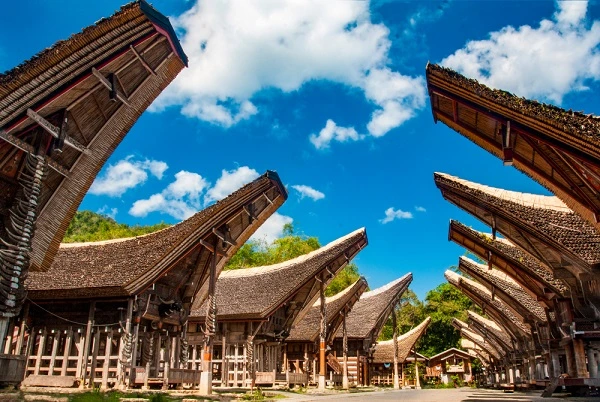
Nestled in the highlands of Sulawesi, Indonesia, the Toraja region is renowned for its rich cultural heritage and breathtaking landscapes. The Toraja people, known for their distinct customs and traditions, offer a fascinating glimpse into one of Indonesia’s most unique and vibrant cultures. This article explores the captivating aspects of Toraja culture, from their traditional ceremonies to their distinctive architecture and art.
1. The Toraja People: An Overview

Historical Background
The Toraja people, indigenous to the mountainous regions of South Sulawesi, have a history steeped in unique cultural practices and beliefs. Their culture has evolved through centuries of isolation, which has helped preserve their distinct traditions.
Language and Ethnicity
The Toraja speak the Toraja language, which belongs to the Austronesian language family. They are divided into several sub-groups, including the Sa’dan, Kalumpang, and Rantepao.
2. Traditional Architecture: Tongkonan Houses

The Tongkonan
One of the most iconic elements of Toraja culture is the Tongkonan, traditional wooden houses with a distinctive boat-shaped roof. These homes are not only architectural marvels but also hold deep cultural significance.
- Design and Structure: Tongkonan houses are elevated on wooden piles and feature intricate carvings and decorations. The roof’s boat-like shape symbolizes the Toraja’s belief in their ancestral connections to the sea.
- Symbolism: The carvings and decorations on Tongkonan houses often represent symbols of fertility, prosperity, and protection from evil spirits. Each design element tells a story or conveys a message from Toraja mythology.
Rice Barns (Lonti')
Adjacent to the Tongkonan are the rice barns, known as Lonti'. These structures, also adorned with carvings, are used to store rice, a staple food in Toraja culture. The barns are often elaborately decorated and serve as a symbol of wealth and prosperity.
3. Traditional Ceremonies and Rituals

Funeral Rites
Toraja funeral ceremonies, known as Rambu Solo', are some of the most elaborate and culturally significant rituals in Indonesia. These ceremonies can last several days and involve intricate rites and ceremonies.
- Ceremony Overview: Funerals are seen as a crucial passage from the earthly realm to the afterlife. The ceremonies include traditional dances, music, and the slaughter of buffaloes, which are believed to help guide the deceased to the afterlife.
- Buffalo Sacrifice: The number of buffalo sacrificed during a funeral is a significant indicator of the deceased's social status and the family’s wealth. The more buffalo sacrificed, the higher the honor and respect bestowed upon the deceased.
Wedding Ceremonies
Toraja weddings are elaborate events that involve multiple stages and significant cultural practices. The ceremonies are characterized by traditional dances, music, and the exchange of gifts.
- Pre-Wedding Rituals: Before the wedding, there are several rituals to ensure compatibility between the bride and groom. These include traditional consultations and blessings from family elders.
- Wedding Festivities: The wedding itself is a grand affair with traditional costumes, music, and dances. The ceremony reflects the Toraja’s respect for ancestry and community ties.
4. Art and Craftsmanship

Traditional Crafts
Toraja art is renowned for its intricate craftsmanship and vibrant designs. Traditional crafts include wood carvings, weaving, and embroidery.
- Wood Carvings: Toraja wood carvings, often seen on Tongkonan houses and rice barns, depict various animals, mythical figures, and ancestral symbols. These carvings are meticulously crafted and carry deep cultural meaning.
- Weaving and Embroidery: Traditional Toraja textiles are woven with intricate patterns and vibrant colors. These textiles are used in ceremonial attire and are highly valued for their beauty and craftsmanship.
Sculptures and Masks
Toraja masks and sculptures are used in various rituals and ceremonies. These items are crafted with symbolic designs and are often used to represent ancestral spirits or deities.
5. Festivals and Cultural Events

Ma’nene Festival
The Ma’nene Festival, also known as the “Ceremony of Cleaning Corpses,” is a unique event held every few years in Toraja. During this festival, families exhume and clean the remains of their ancestors, redress them in new clothes, and celebrate their lives with music and dance.
Rambu Solo' Festival
Apart from funerals, Rambu Solo' festivals can also be held to celebrate significant life events such as births or anniversaries. These festivals are characterized by traditional performances, rituals, and communal feasts.
6. Experiencing Toraja Culture

Visiting Toraja
Travelers to Toraja can experience the culture firsthand by visiting traditional villages, participating in cultural ceremonies, and exploring the stunning landscapes of the region. Key destinations include the towns of Rantepao, Makale, and the Batutumonga highlands.
Engaging with Locals
To gain a deeper understanding of Toraja culture, engage with local communities and participate in cultural tours. Respect local customs and traditions, and seek permission before photographing ceremonial events or sacred sites.
Culinary Experiences
Toraja cuisine offers a unique taste of local flavors. Try traditional dishes such as Coto Toraja (a spicy meat soup), Pa’piong (spiced meat wrapped in banana leaves), and traditional coffee.
Conclusion
The Toraja people offer a fascinating glimpse into one of Indonesia’s most unique and culturally rich communities. Their distinctive architecture, elaborate ceremonies, and traditional crafts provide a profound insight into their way of life and beliefs. By visiting Toraja and engaging with its people, you can experience firsthand the beauty and depth of their culture, creating memories that will last a lifetime.
